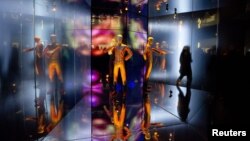LONDON —
Ziggy played guitar. But as a new exhibition devoted to singer David Bowie's long and innovative career makes clear, he also wrote lyrics, checked every detail of his outlandish costumes, appeared in movies and helped design his own stage sets.
"David Bowie is," which runs from March 23 to Aug. 11, has broken box office records at London's Victoria & Albert Museum, with 50,000 advance tickets sold.
Organizers at a press preview on Wednesday were at pains to point out that more tickets were available and the demand underlines 66-year-old Bowie's lasting impact on music, fashion, video and beyond.
It also coincides with the release just over a week ago of Bowie's new album "The Next Day," his first new material for a decade. The record hit number one in the British album charts at the weekend, marking his return to the top after 20 years.
"His radical innovations across music, theatre, fashion and style still resound today in design and visual culture and he continues to inspire artists and designers throughout the world," said Martin Roth, director of the V&A.
Drawing heavily on the David Bowie Archive, the show features more than 300 objects, with pride of place going to Bowie's stage costumes which allowed him to adopt alternative personas and create an aura of mystery and invention.
Among the recognizable outfits are a striped bodysuit by Japanese designer Kansai Yamamoto for the Aladdin Sane tour in 1973 and the Pierrot costume by Natasha Korniloff which featured in the groundbreaking music video for "Ashes to Ashes."
"Seismic Shift"
Among the costumes on display from Bowie's "Ziggy Stardust" phase is the blue, gold and red padded jumpsuit by Freddie Burretti that marked a turning point in Bowie's career.
He wore the suit for a performance of "Starman" on Britain's TV chart show "Top of the Pops" on July 6, 1972 complete with flame-orange hair, make-up and red patent boots, representing what organizers called a "seismic shift" in pop culture.
People were intrigued and appalled in equal measure at the sight of the otherwordly androgynous being, a bold new creation which has inspired performers ever since.
True to Bowie's multimedia experimentation, the show includes footage from famous concerts shown on giant screens as well as a mime show enacted by Bowie in 1969 which anticipates the downside of becoming famous.
His attention to detail can be seen throughout.
On a design sketch for an outfit to be worn on the U.S. "Saturday Night Live" show Bowie wrote: "may be I'm wrong about color? What do you think."
He also appeared not to take himself too seriously, describing a short bodysuit, designed by Yamamoto, as his "impossibly silly 'bunny' costume."
He soaked up culture and history wherever he went, including his stay in Berlin in the late 1970s where he absorbed Brecht, cabaret and Expressionist art and produced three acclaimed albums - "Low," "Heroes" and "Lodger."
He recorded a Mandarin version of his 1997 song "Seven Years in Tibet," reflecting his interest in the region and its Buddhist religion.
The track prompted one Chinese fan to write, in a note on display at the exhibition: "I think I am flying in the sky when I listen to your Mandarin song, you know!"
The displays are accompanied by an impressive soundtrack that includes hits like "Space Oddity," "Changes" and "Under Pressure," which he released with Queen in 1981.
In fact, all that is missing from "David Bowie is" is the man himself. If he were to visit, it would most likely be incognito, as Bowie has shunned the limelight altogether for much of the last decade.
"We're really hoping David does appear at some point," said co-curator Geoffrey Marsh.
"David Bowie is," which runs from March 23 to Aug. 11, has broken box office records at London's Victoria & Albert Museum, with 50,000 advance tickets sold.
Organizers at a press preview on Wednesday were at pains to point out that more tickets were available and the demand underlines 66-year-old Bowie's lasting impact on music, fashion, video and beyond.
It also coincides with the release just over a week ago of Bowie's new album "The Next Day," his first new material for a decade. The record hit number one in the British album charts at the weekend, marking his return to the top after 20 years.
"His radical innovations across music, theatre, fashion and style still resound today in design and visual culture and he continues to inspire artists and designers throughout the world," said Martin Roth, director of the V&A.
Drawing heavily on the David Bowie Archive, the show features more than 300 objects, with pride of place going to Bowie's stage costumes which allowed him to adopt alternative personas and create an aura of mystery and invention.
Among the recognizable outfits are a striped bodysuit by Japanese designer Kansai Yamamoto for the Aladdin Sane tour in 1973 and the Pierrot costume by Natasha Korniloff which featured in the groundbreaking music video for "Ashes to Ashes."
"Seismic Shift"
Among the costumes on display from Bowie's "Ziggy Stardust" phase is the blue, gold and red padded jumpsuit by Freddie Burretti that marked a turning point in Bowie's career.
He wore the suit for a performance of "Starman" on Britain's TV chart show "Top of the Pops" on July 6, 1972 complete with flame-orange hair, make-up and red patent boots, representing what organizers called a "seismic shift" in pop culture.
People were intrigued and appalled in equal measure at the sight of the otherwordly androgynous being, a bold new creation which has inspired performers ever since.
True to Bowie's multimedia experimentation, the show includes footage from famous concerts shown on giant screens as well as a mime show enacted by Bowie in 1969 which anticipates the downside of becoming famous.
His attention to detail can be seen throughout.
On a design sketch for an outfit to be worn on the U.S. "Saturday Night Live" show Bowie wrote: "may be I'm wrong about color? What do you think."
He also appeared not to take himself too seriously, describing a short bodysuit, designed by Yamamoto, as his "impossibly silly 'bunny' costume."
He soaked up culture and history wherever he went, including his stay in Berlin in the late 1970s where he absorbed Brecht, cabaret and Expressionist art and produced three acclaimed albums - "Low," "Heroes" and "Lodger."
He recorded a Mandarin version of his 1997 song "Seven Years in Tibet," reflecting his interest in the region and its Buddhist religion.
The track prompted one Chinese fan to write, in a note on display at the exhibition: "I think I am flying in the sky when I listen to your Mandarin song, you know!"
The displays are accompanied by an impressive soundtrack that includes hits like "Space Oddity," "Changes" and "Under Pressure," which he released with Queen in 1981.
In fact, all that is missing from "David Bowie is" is the man himself. If he were to visit, it would most likely be incognito, as Bowie has shunned the limelight altogether for much of the last decade.
"We're really hoping David does appear at some point," said co-curator Geoffrey Marsh.










